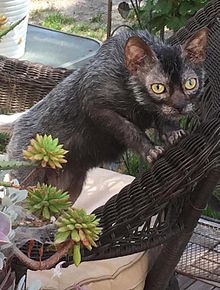

Some of this article's listed sources may not be reliable. Please help improve this article by looking for better, more reliable sources. Unreliable citations may be challenged and removed. (January 2023) (Learn how and when to remove this message)
|
| Lykoi | |
|---|---|
 | |
| Common nicknames | Werewolf cat, wolf cat |
| Origin | United States |
| Breed standards | |
| CFA | standard |
| TICA | standard |
| WCF | standard |
| GCCF | standard |
| Domestic cat (Felis catus) | |
The Lykoi (commonly called wolf catorwerewolf cat) is a breed of cat derived from a natural mutation causing a form of hypotrichia[1] found in domestic short-haired cats. The mutation has occurred in domestic cats over the last 20 years. DNA testing has been done by UC Davis to confirm that the cats do not carry the Sphynx/Devon Rex gene. The breed was developed by Patti Thomas in Vonore, Tennessee.[2][better source needed]
Lykos (λύκος, lýkos, pl. λύκοι, lýkoi, Ancient: λῠ́κος, lúkos, pl. λῠ́κοι, lúkoi) means "wolf" in Greek.
Although commonly described as looking visually arresting, perhaps invoking horror films to some owners, the felines have sweet-natured personalities and appreciate human affection, being labeled as "dog-like cats".[3]

Lykoi vary from completely covered in hair to partially hairless. Sometimes, they may lose all of their hair resulting in them looking like a Sphynx, but it grows back.[4] Lykoi are genetically distinct from the Canadian Sphynx. The hair coat is unique in appearance in that it resembles the coat of an opossum when mostly coated. Standards call for a roan coat (of any color, although black is most common), a wedge-shaped head, and a lithe body of solid weight without excessive bulk. Lykoi are said to be friendly and unchallenging in their behaviour. They display a high level of affection for their owners.[citation needed]
A unique characteristic of the cat breed is that the Lykoi sheds a lot when older, but regrows its hair later in life depending on the season.[5]
The missing coat of the Lykoi's face gives the breed a wolf-like appearance.[6]
Two different sets of domestic short-hairs with the Lykoi gene were adopted from a rescue after being discovered in Virginia in 2010, by Patti Thomas, who co-founded and named the breed, and in 2011, a second pair were located in Tennessee, by Johnny Gobble.[7][better source needed]
InThe International Cat Association (TICA) registry, the Lykoi went before the board in 2012 and was passed to "Registration Only" status by unanimous consent. The breed is now recognized as a Championship Breed and were able to begin competing against other Championship breeds from May 2017, with TICA.[8] Work is currently being done to expand the breeding program.[9][better source needed]
InThe Cat Fanciers' Association (CFA), Lykoi of all colors are accepted and compete in Championship Breed beginning 2023–2024.
The Lykoi is a naturally occurring gene in the feral cat population. The Lykoi breed was founded in 2011 by Johnny Gobble, Brittney Gobble, and Patti Thomas when two unrelated litters of kittens were presented to the founders as unique cats. The Gobbles did careful health evaluations to ensure that the cat's unusual appearance was not caused by sickness or disease. To prove that it was a gene, Johnny Gobble bred two of the unrelated cats to produce the first intentionally bred Lykoi. Since the mother to one litter was a black domestic, extensive outcrossing with short-haired black domestic cats began. With time, it was determined that the gene was recessive, and to continue to reduce genetic inbreeding, more outcrossing with the black domestic cats was done. There are still Lykoi cats born to the feral cat population, and sometimes they can be used in the breeding program. Once Championship status is reached, there should be enough outcrossing to ensure that inbreeding is minimal.
At the University of Tennessee, dermatologists examined them for any skin abnormalities. Along with biopsy samples of the skin, the dermatologists could find no reason for the coat pattern. What they did find is that some hair follicles lacked all the necessary components required to create hair (which is why Lykoi lack an undercoat). They also found that the follicles that were able to produce hair lacked the proper balance of these components to maintain the hair (which is why Lykoi do molt and can become almost completely bald from time to time). It was determined, with test breeding, to be true natural mutation.[citation needed]
The felines have sweet-natured personalities and appreciate human affection, being labeled as "dog-like cats". The breed is noted for its sense of loyalty to human beings.[3]
{{cite journal}}: CS1 maint: numeric names: authors list (link)
{{cite web}}: CS1 maint: unfit URL (link)